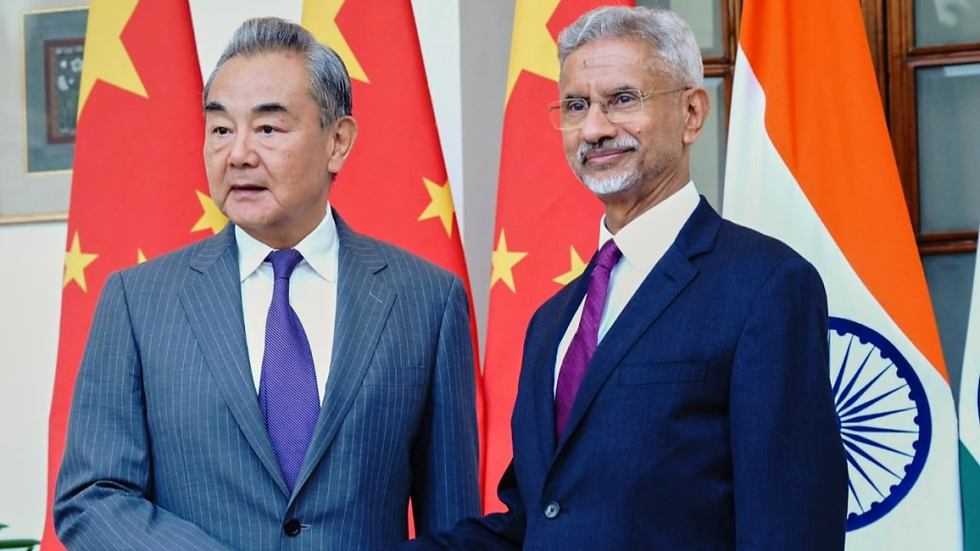India and China Seek a New Beginning: From Border Tensions to Strategic Partnership
- MGMMTeam

- Aug 20
- 3 min read
In a significant diplomatic exchange, India and China have moved a step closer towards repairing ties strained by years of mistrust and confrontation. During his visit to New Delhi, Chinese Foreign Minister Wang Yi called on both nations to see each other as partners rather than rivals. His remarks underscored Beijing’s willingness to reset ties at a time when global headwinds are reshaping economic and security priorities across Asia.
For India, External Affairs Minister S. Jaishankar set the tone with a firm but balanced message: differences between the two countries are inevitable, but they must not be allowed to escalate into disputes. He reiterated that peace and tranquillity along the Line of Actual Control (LAC) remain a prerequisite for advancing bilateral cooperation in any meaningful way.

Healing After Galwan
The road to rapprochement has been long and uneasy. The 2020 Galwan Valley clash, which claimed lives on both sides, marked a turning point in India–China relations. Trust evaporated, and the border region became a flashpoint for military standoffs. Since then, multiple rounds of talks have sought to stabilize the situation.
Now, the mood is shifting. Both governments acknowledge that the frontier has remained largely calm in recent months. National Security Adviser Ajit Doval, after meeting Wang Yi, noted that ties are showing a “sustained upward trend” and are becoming “more substantive.” This sense of quiet progress reflects a mutual understanding that prolonged hostility is costly and unsustainable.
The Economic Dimension of Cooperation
Beyond the border, the dialogue has taken a practical turn with both sides focusing on economic revival. India and China are exploring ways to restore direct flights, simplify visas, and reopen border trade routes that have remained suspended since tensions peaked. Such steps carry economic weight for local communities and signal intent to normalize ties.
Equally significant is China’s pledge to support India in securing crucial resources. Beijing has assured New Delhi of stable supplies of rare earth minerals, fertilizers, and tunnel-boring machines, items central to India’s industrial and infrastructure ambitions. If implemented faithfully, these measures could ease long-standing concerns over the structural imbalance in bilateral trade, where India’s deficit with China has been a persistent sore point.
Global Pressures Driving Convergence
This diplomatic thaw cannot be separated from broader global realities. Both India and China are grappling with rising U.S. tariffs and disruptions in global trade that threaten their economic stability. The overlapping challenges have nudged the two Asian giants toward cooperation, even if tactical in nature.
Wang Yi’s remarks about resisting “unilateral bullying” were seen as a veiled reference to Washington’s protectionist policies. India, while not fully aligned with China’s worldview, recognizes the strategic advantage of easing border tensions when global institutions are under stress and supply chains are being realigned.
The Role of Past Agreements
The current dialogue is not being built from scratch but rests on the foundation of past agreements that continue to shape interactions. The 1993 Border Peace and Tranquility Agreement laid down the rules for troop management along the frontier, while the 2024 Border Patrol Agreement helped restore patrol mechanisms after the Galwan standoff. These frameworks remain vital in preventing misunderstandings and creating space for sustained diplomacy.
Looking Toward Modi’s Visit
The next crucial milestone will come at the Shanghai Cooperation Organisation (SCO) Summit in Tianjin, where Prime Minister Narendra Modi is expected to meet President Xi Jinping. This encounter will provide an opportunity to translate cautious optimism into concrete political will. A successful summit could mark the most substantial forward movement in ties since 2020 and shape the trajectory of India–China relations for years to come.
Conclusion: A Fragile Yet Necessary Reset
India and China are at a crossroads where cooperation is no longer optional but necessary. The wounds of Galwan have not fully healed, and deep mistrust lingers. Yet the present convergence shows that both sides understand the costs of prolonged confrontation.
The real test lies in whether border de-escalation continues and whether economic assurances are honored in practice. If these steps hold, this reset could pave the way for a more stable and pragmatic partnership. If not, the relationship risks slipping back into suspicion and hostility. For now, the signals suggest a fragile but promising attempt to turn the page.
(Sources: Financial Express, Moneycontrol, Times of India)




Comments